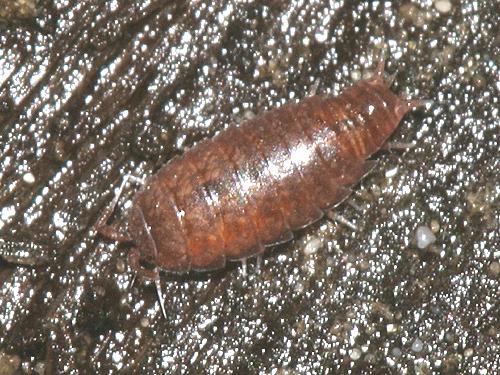1) Taxonomy
Kingdom Animalia
Phylum Arthropoda
Subphylum Crustacea
Class Malacostraca
Superorder Peracarida
Order Isopoda
Suborder Oniscidea
Family Trichoniscidae
Genus Hyloniscus
Species Hyloniscus riparius (Koch, 1838)
2) Habitat
Hyloniscus riparius is a species of woodlouse found in Europe, mostly in Central and Eastern Europe and subsequently introduced to North America. It is strongly associated with flood plains. Although it is a common species it is difficult to find, as it lives underground.
Hyloniscus riparius belongs to the family Trichoniscidae. This family consists of those Isopods, which left their terrestrial habitat and return to their origins at the water.
Common to all sites for H.riparius is the high moisture content of the ground. Hyloniscus riparius has been found in damp sites such as lakeshores and river banks, and in damp microhabitats such as the water seeps from rocks in a quarry.
In Hungary H. riparius is among the 6 most common isopod species. It is the only one among these which is in underground active.
In Europe a review on the Dutch fauna classifies H. riparius into the category „moderately common”.
3) Morfology
Features that distinguish it from other Trichoniscidae:
- Its size which is about 3−5mm, females somewhat bigger, occasionally to 6.5 mm.
- The flagelli on the antennae have 7 articles.
- It has only 1 ocellus in the eyes.
- Red-wine color.
- It is a fast animal.
This isopod quickly desiccates and expires when removed from its habitat and placed for example in an empty collecting container. Two factors account for this susceptibility in H. Riparius. One is its exceptionally small size and the other is that it lacks pseudotracheae (“humidity chambers” for oxygen exchange) on its abdominal pleopods, which in other terrestrial isopods act to conserve body moisture. Thus it is more strictly confined to moist habitats than some other terrestrial isopod species.
4) Food
H. Riparius, like other Oniscidae, is feeding mostly on dead plant matter, microorganisms, hifa and recycling nutrients back into the soil.
Research has testified that among among isopodae coprofagy, eating their own excrement is common practice. This helps to regain the flora of their intestine and some important materials. Young creatures do not develop satisfactorily if they do not get to their excrements.
5) Reproduction
The reproduction of Trichoniscidae goes two ways: the usual way by sexing that combines the genes of the male and the female and by “cloning”, when the female reproduces a copy of herself with identific cromosomes. In this latter case the descendant is naturally a female. This might be the reason why 70−80 percent of the population consists of females. For terrestrial isopods in temperate climates, the majority of individuals live slightly longer than one year with young adults from the prior season mating and giving birth to the next generation during their second summer. They take 1−3 turns of laying eggs a year,the number depending on the local climate. The developmental process takes place inside the female’s marsupium and can be seen through the oostegites (transparent overlapping body flaps). This allows further classification of gravid females into two subgroups, those whose broods are still at the egg/embryo stage and those whose broods have developed to the manca stage. Mancas are white miniature adults who are active inside the marsupium for at least several days before they become independent. Individuals survive about 2 years, some even 3.
6) Role in the ecosystem
H. riparius, like all terrestial isopods break down organic vegetation, especially leaf litter, and they play an important role in the formation of humus. They form an important component of the larger decomposer fauna, along with earthworms, snails, and millipedes. All of these animals return organic matter to the soil where it is further digested by fungi, protozoans, and bacteria, hence making nitrates, phosphates, and other vital nutrients available to plants. Although they may occasionally feed on roots, they do minimal damage to live vegetation and should not be regarded as pests. From this respect individual species do not differ. The difference is that they fill many different ecological niches. In general, various sorts of Terrestrial isopods are distributed according to the moisture content of their habitats, which can vary from wet to dry determined by rainfall, and evaporation. They cannot survive in sunlight and are nocturnal and cryptozonic and mainly active at night.
7) Endangered Isopods and the H. riparius
Isopods are resistant and adapting to their environment. They find their habitat in towns. In 2008 there were 39 species of several thousand ones within the Isopoda Order that were put on the Red List of IUCN as endangered species. However, none of these isopods were terrestrial isopods. H.Riparius as a terrestrial isopod is necessarily not endangered.
- http://en.wikipedia.org/wiki/Hyloniscus_riparius
- http://hu.wikipedia.org/wiki/Szárazföldi_ászkarákok
- http://en.wikipedia.org/wiki/Trichoniscus_pusillus
- http://hu.wikipedia.org/wiki/Ászkarákok
- http://bugguide.net/node/view/36221
- http://www.itis.gov/servlet/SingleRpt/SingleRpt?search_topic=TSN&search_value=595380
- Joan Jass and Barbara Klausmeier: The Terrestrial Isopod Hyloniscus Riparius, Wisconsin, The Great Lakes Entomologist Vol. 36, Nos. 1 & 2 in http://decapoda.nhm.org/pdfs/30352/30352.pdf
- George A. Schultz: The Distribution and General Biology of Hyloniscus riparius (Koch) (Isopoda, Oniscoidea) in North America, Crustaceana Vol. 8, No. 2, Mar., 1965 in http://www.ingentaconnect.com/content/brill/cr/1965/00000008/00000002/art00003
- http://insektenfotos.de/forum/print.php?threadid=5732&page=1&sid=7dfd7f002d5d256d7d323bfe1fcb979c
- http://www.itis.gov/servlet/SingleRpt/SingleRpt?search_topic=TSN&search_value=595380
- Hornung Erzsébet, Vilisics Ferenc, Szlávecz Katalin: Hazai szárazföldi ászkarákfajok (Isopoda, Oniscidea) tipizálása két nagyváros, Budapest és Baltimore (ÉK Amerika) összehasonlításának példájáva.l Természetvédelmi Közlemények 13, pp. 47-58, 2007, inhttp://www.univet.hu/users/vilisics/html/Hornung%20etal%20MTBK2007.pdf
